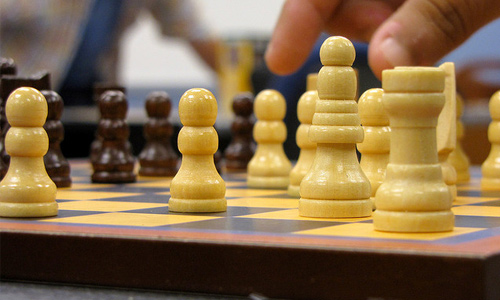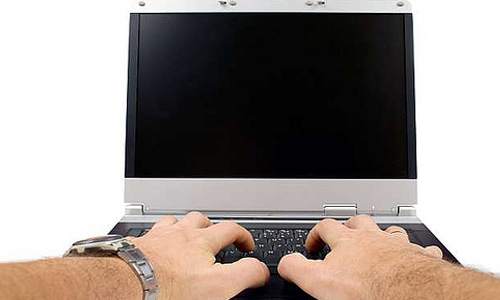Even before you accept your first client, you have to make sure that you are prepared. Other than preparing your skills, you should also know what to do in starting a project. It is always important to follow certain steps and methodology to make sure that you will not miss anything before you start with the project. It would also be a great hassle for your client if you keep on asking them certain things about the project which means you are not totally prepared to work for them.
Actually, most designers really have a design process which they usually present to the client so that the client will also be aware of the project flow. So, if you do not have this, we have here some guide that could help you. It is not necessary for you to follow this but this could aid you in making your own design process.
1. Start of Project.

Image: dunleavymatt
To start the project, the client and the designer have to discuss the details and specifications of the project. The client will feed information to the designer as to what kind of project he wants (if it is a business card, a poster, etc.) for his business. Other than that, he should make it clear to the designer regarding his goals and other things he wants his project to look like. Every single detail has to be clear so that the designer could make the design well according the client’s preferences. If the client and the designer could meet in person, that would be better. If that happens, the designer should be ready with some samples of his work so that it is easier for the client to think of some ideas that he want for the project. In case the client and the designer reside in a location that is so far away from each other, they can still set a meeting and discuss things through Skype. The important thing is both should be able to understand each other really well.
2. Gather information.

Image: ahmedbakir
As you speak with your client, do not forget to ask all the necessary information you will need for the design. You have to know what the client needs. Then ask the following questions:
- What is the purpose of the project?
- Who are the target audience?
- What is the message of the design?
- How many pages are required?
- What are the dimensions?
- How many colors does he want to use? What are these?
- Is there a specific design he wants you to match with?
- Is there a specific budget?
- Is there a deadline for completion?
- Can the client provide examples of design they like?
3. Research More.

Image: Eibo-Jeddah
After the client provides you with all the necessary information you need, you will still have to dig deeper and gather more information. This will help you get to the right track. Another thing is, the client will surely be impressed for you have shown interest in the project to guarantee that you could really give them what they truly want. You-the designer should do a creative briefing as to what you plan for the project based on the information you have in hand. Then you will have to inquire about the competitive landscape. When we say competitive landscape, it talks about the analysis of your client’s competitors both online and offline. This will help you analyze how you can make your design stand out from the competitors. Next thing that you have to take note of is marketing. What is the effective marketing strategy that you can use to get the consumer’s eyes? How will your design help in attaining your client’s goals if we speak of marketing? Then deal with the design. Ask the client what medium he wants to use-it could be print or web and know about the technical stuff like dimensions. Also, present your ideas on how to make the design better.
4.Use a Strategy.

Image: colemama
Now you have to work on your strategy to make your design well. Analyze all the information that you have gathered and apply it in your design. Make sure also that the design you make is functional and appropriate for the client’s requirements. Considering the research that you have done which includes the competitors, the market and the design, you have to create a strategy so that what you will work on will be effective and will touch all those important aspects. Make your mind work really well to create a good design and a good reasoning also. Apart from the design, you should know the purpose of the things that you put into the design and be able to perfectly discuss your creation. After you have done that, you can tell your client about it so that he could add some additional input.
5. Polish Creativity.

Image: ckaroli
Of course, your design should be creative. Before you start working on the project, you have to inspire yourself in order to get a good output. There are certain things that stir up the creativity of a person. Some might find it beneficial to take a walk in the park or to read a book or maybe talk with friends. One could also browse the internet for inspiration or visit museums or read a book. There are million different ways to let that creative juice flow. It varies from one person to another. The important thing there is, you should be creative when you start working. It might not be easy to stay creative but you could if you only try. Also, do not forget to look into the design your client wants to match.
6. Design Development.

Image: proxcompu
After the client approves your design strategy, you can now start making your design. Every designer has his own way of doing it. We can call that a designer’s methodology. Some start by sketching on a paper, others do mind mapping; others experiment using their chosen software. But whatever you do, you just have to make sure that you won’t spend too much time with the first steps. You have to try what is on your mind and if it works well, then continue doing it. Take note of the inputs your client has given you to make sure the goals of the project is being met.
7. Make multiple versions.

Image: marekkosmal
When you have finished your first design- that is the first design that came to your mind, you can now make other versions of it. While working, you could have thought of a new idea to for the design or you could of thought of some other things to add. You can do that now on your other versions of the design. As you keep on working and more ideas are have came up, you could make around 3-5 designs already. Choose your best designs from that and present it to the client. But do not throw away or delete those designs which you did not present to the client. Just keep it because it could still be used in the future.
8. Project Revisions.

Image: Connect2group
When you have shown your designs to the client, there will surely be some minor revisions on some aesthetic elements. Discuss it well with the client. Everything should be clear as to which part he would like to modify. Let the client know that you can mix and match the design versions you have made. There could be an instance that the client wants the background of the other design and wants use some elements from another design. That is okay. You can work on that after. There might be a lot of revisions the client wants, so to do away with this, you and your client should agree as to how many revisions you will be doing until the final design. You wouldn’t want to spend a lot of time just revising one design for a client.
9. Production of Design.

Image: northstartechnologyguide
Once the client approves your design, you will now discuss matters with regards to the printing if it is on print. You can suggest what type of paper to use and where he could have it printed if you did not include printing in the contract. If it is an online transaction, make sure that everything is complete when you send it to them.
10. Completion.

Image: Carenet Healthcare Services
In the completion of the project, the client gives you the full payment and you still have to discuss some matters with them. You can tell them important things to make sure that your design will look good when used. You might be asked to write something about the design and give it to the client as a support to your work. Also, close the invoices by the time the client pays. You can talk to your client that if they were happy with your work, you are still willing to work with them for future projects. You can also ask for referrals from them.
By the time you have made your own design process, make sure that you will not skip the steps. Finish the first one before going to the next. You can actually make your own project outline. It is up to you on how you will do it. Other’s have longer and more detailed design process. What we have provided here is merely a guide in making your own. Can you share to us some steps of your design process that you find beneficial?








Great article! Thanks for the info. well organize..
thanks for the tips its really a big help for me how to start my own design..
a big thanks to you guys!
Another great article well done.
Really very well organize article . m sure to follow in nearest day of mine.
Thanks for sharing….(-_-)
Great tips.Straight to the point.
Its definitely is going to help make designing alot easier and save alot of time.
Thanks alot for your time and effort
All very true – something about managing the client (perhaps the hardest thing of all?) would have been great too, but a really clear post.